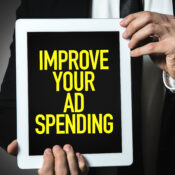/
/
Keeping Users Engaged Below the Fold
The fold is the line separating where you can read on first arrival to a site, and where you have to scroll. This term was first used by print, referring to the fold on the front page of the newspaper. There is a lot of debate whether the fold is still important in web design. Yes, it is important to keep key elements above the fold, but you can also utilize the space below the fold by keeping user’s interest. Your call-to-action doesn’t always have to be at the top of your page.
“People will look very far down a page if (a) the layout encourages scanning, and (b) the initially viewable information makes them believe that it will be worth their time to scroll.” – Jakob Nielsen
In the above vs. below the fold battle, who wins? The answer: it depends.
 You want to keep your audience craving more, not only with images but also with content. After all, content is king. You want to give your visitors a glimpse of what your site is about, but give them motivation to keep reading.
You want to keep your audience craving more, not only with images but also with content. After all, content is king. You want to give your visitors a glimpse of what your site is about, but give them motivation to keep reading.
 Take a look at this comparison of the Kia Sorento page compared to the Nissan Pathfinder page. As you can see, the Nissan page pulls your attention to keep scrolling.
Take a look at this comparison of the Kia Sorento page compared to the Nissan Pathfinder page. As you can see, the Nissan page pulls your attention to keep scrolling.


 I’ve collected some more examples of websites that grab your attention to go beyond the fold. Happy scrolling!
I’ve collected some more examples of websites that grab your attention to go beyond the fold. Happy scrolling!






 You want to keep your audience craving more, not only with images but also with content. After all, content is king. You want to give your visitors a glimpse of what your site is about, but give them motivation to keep reading.
You want to keep your audience craving more, not only with images but also with content. After all, content is king. You want to give your visitors a glimpse of what your site is about, but give them motivation to keep reading.
 Take a look at this comparison of the Kia Sorento page compared to the Nissan Pathfinder page. As you can see, the Nissan page pulls your attention to keep scrolling.
Take a look at this comparison of the Kia Sorento page compared to the Nissan Pathfinder page. As you can see, the Nissan page pulls your attention to keep scrolling.

 I’ve collected some more examples of websites that grab your attention to go beyond the fold. Happy scrolling!
I’ve collected some more examples of websites that grab your attention to go beyond the fold. Happy scrolling!






Recent Posts
Mudd Advertising
Let’s leverage!
Mudd Advertising
Politics Schmolitics!
Mudd Advertising
Mudd has been promoted to Google Premier Partner
All Categories
Tags
anonymous website visitor identification
automotive
branding
cable
case study
chevrolet
chevy
data
digital marketing
direct marketing
display
dynamic inventory display
facebook
first party
google
google analytics
google premier partner
internet marketing
local seo
Matthew Moody
media
mobile search
mobile seo
MUDDid
online marketing
online video
organic
organic search
pay per click
political
ppc
promotion
retargeting
search engine marketing
search engine optimization
sem
seo
social advertising
social media
social media marketing
strategy
traditional marketing
traditional media
Volunteer Spotlight
youtube




